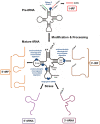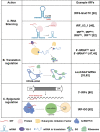tRNA-derived RNA fragments in cancer: current status and future perspectives
- PMID: 32887641
- PMCID: PMC7487644
- DOI: 10.1186/s13045-020-00955-6
tRNA-derived RNA fragments in cancer: current status and future perspectives
Abstract
Non-coding RNAs (ncRNAs) have been the focus of many studies over the last few decades, and their fundamental roles in human diseases have been well established. Transfer RNAs (tRNAs) are housekeeping ncRNAs that deliver amino acids to ribosomes during protein biosynthesis. tRNA fragments (tRFs) are a novel class of small ncRNAs produced through enzymatic cleavage of tRNAs and have been shown to play key regulatory roles similar to microRNAs. Development and application of high-throughput sequencing technologies has provided accumulating evidence of dysregulated tRFs in cancer. Aberrant expression of tRFs has been found to participate in cell proliferation, invasive metastasis, and progression in several human malignancies. These newly identified functional tRFs also have great potential as new biomarkers and therapeutic targets for cancer treatment. In this review, we focus on the major biological functions of tRFs including RNA silencing, translation regulation, and epigenetic regulation; summarize recent research on the roles of tRFs in different types of cancer; and discuss the potential of using tRFs as clinical biomarkers for cancer diagnosis and prognosis and as therapeutic targets for cancer treatment.
Keywords: Biomarkers; Cancer; Epigenetic regulation; RNA silencing; Translation regulation; tRNA-derived fragments.
Conflict of interest statement
No potential conflicts of interest were disclosed.
Figures




Similar articles
-
The Roles of tRNA-Derived Fragments in Cancer: Updates and Perspectives.Int J Mol Sci. 2025 Jun 17;26(12):5822. doi: 10.3390/ijms26125822. Int J Mol Sci. 2025. PMID: 40565284 Free PMC article. Review.
-
tRNA-derived fragments: Mechanisms underlying their regulation of gene expression and potential applications as therapeutic targets in cancers and virus infections.Theranostics. 2021 Jan 1;11(1):461-469. doi: 10.7150/thno.51963. eCollection 2021. Theranostics. 2021. PMID: 33391486 Free PMC article. Review.
-
tRF2Cancer: A web server to detect tRNA-derived small RNA fragments (tRFs) and their expression in multiple cancers.Nucleic Acids Res. 2016 Jul 8;44(W1):W185-93. doi: 10.1093/nar/gkw414. Epub 2016 May 13. Nucleic Acids Res. 2016. PMID: 27179031 Free PMC article.
-
tRNA-derived fragments: Unveiling new roles and molecular mechanisms in cancer progression.Int J Cancer. 2024 Oct 15;155(8):1347-1360. doi: 10.1002/ijc.35041. Epub 2024 Jun 12. Int J Cancer. 2024. PMID: 38867475 Review.
-
Extracellular vesicles-associated tRNA-derived fragments (tRFs): biogenesis, biological functions, and their role as potential biomarkers in human diseases.J Mol Med (Berl). 2022 May;100(5):679-695. doi: 10.1007/s00109-022-02189-0. Epub 2022 Mar 24. J Mol Med (Berl). 2022. PMID: 35322869 Free PMC article. Review.
Cited by
-
Expression profiles of exosomal tRNA-derived fragments and their biological functions in lipomas.Front Cell Dev Biol. 2022 Aug 10;10:942133. doi: 10.3389/fcell.2022.942133. eCollection 2022. Front Cell Dev Biol. 2022. PMID: 36035989 Free PMC article.
-
Expression Profiles of tRNA-Derived Small RNAs and Their Potential Roles in Primary Nasopharyngeal Carcinoma.Front Mol Biosci. 2021 Dec 20;8:780621. doi: 10.3389/fmolb.2021.780621. eCollection 2021. Front Mol Biosci. 2021. PMID: 34988117 Free PMC article.
-
A novel 3'tRNA-derived fragment tRF-Val promotes proliferation and inhibits apoptosis by targeting EEF1A1 in gastric cancer.Cell Death Dis. 2022 May 18;13(5):471. doi: 10.1038/s41419-022-04930-6. Cell Death Dis. 2022. PMID: 35585048 Free PMC article.
-
Genome-wide interrogation of transfer RNA-derived small RNAs in a mouse model of traumatic brain injury.Neural Regen Res. 2022 Feb;17(2):386-394. doi: 10.4103/1673-5374.314315. Neural Regen Res. 2022. PMID: 34269214 Free PMC article.
-
A novel tyrosine tRNA-derived fragment, tRFTyr, induces oncogenesis and lactate accumulation in LSCC by interacting with LDHA.Cell Mol Biol Lett. 2023 Jun 26;28(1):49. doi: 10.1186/s11658-023-00463-8. Cell Mol Biol Lett. 2023. PMID: 37365531 Free PMC article.
References
Publication types
MeSH terms
Substances
LinkOut - more resources
Full Text Sources
Other Literature Sources
Medical

